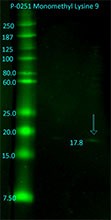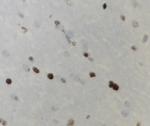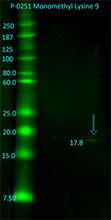- Clone
- 7E7.H12 (See other available formats)
- Regulatory Status
- RUO
- Other Names
- Histone H3.1, histone H3/a, histone 1, H3/a, H3 histone family, member A
- Previously
-
Covance Catalog# MMS-5084
- Isotype
- Mouse IgG1, κ

-

Western Blot analysis showing anti-Histone H3 Monomethyl (Lys9) specificity: Lane 1: Molecular Weight Marker; Lane 2: 5 µg human HeLa cell lysate; Lane 3: 10 µg human HeLa cell lysate. -

Staining of monomethyl Lysine 9 Histone H3 (7E7.H12) on frozen mouse brain at 10 µg/ml.
| Cat # | Size | Price | Quantity Check Availability | ||
|---|---|---|---|---|---|
| 824201 | 100 µL | $335.00 | |||
Chromosomal DNA wraps around histone proteins located in the nucleus of the cell. Histone H3 is one of the five main histone proteins. Featuring a main globular domain and a long N-terminal tail, H3 forms nucleosomes with the 'beads on a string' structure. Histone proteins are highly post-translationally modified and Histone H3 is the most extensively modified. The term "Histone H3" does not distinguish between sequence variants or modification state - including three sequence variants H3.1, H3.2, and H3.3. Histone H3 is important in the field of epigenetics, where its sequence variants and variable modification states are thought to play a role in the dynamic and long term regulation of genes. Histone H3 lysine 9 (H3K9) is a major site of chromatin regulation. The N-terminal tail of histone H3 protrudes from the globular nucleosome core and can undergo several different types of post-translational modification that influence cellular processes. These modifications include the covalent attachment of methyl or acetyl groups to lysine and arginine amino acids as well as phosphorylation events. Di- and Tri-methylation of Lysine 9 are associated with repression and heterochromatin, while mono-methylation of K4 is associated with active genes and has been associated with gene silencing and the formation of relatively inactive regions of DNA known as heterochromatin. When H3K9 is acetylated, its neutral charge cannot bind to DNA, resulting in greater access of transcriptional enzymes to DNA. When H3K9 is unmodified, less transcription occurs. The greater the methylation on H3K9, the greater the transcriptional repression.
Product Details
- Verified Reactivity
- Human, Mouse
- Reported Reactivity
- Rat
- Antibody Type
- Monoclonal
- Host Species
- Mouse
- Immunogen
- This monoclonal antibody was raised against a synthetic peptide from human histone H3, mono-methylated at Lysine-9.
- Formulation
- Phosphate-buffered solution.
- Preparation
- The antibody was purified by affinity chromatography.
- Concentration
- 1 mg/ml
- Storage & Handling
- This antibody should be handled aseptically as it is free of preservatives such as Sodium Azide. Store this antibody undiluted between 2°C and 8°C. Please note the storage condition for this antibody has been changed from -20°C to between 2°C and 8°C. You can also check the vial label or CoA to find the proper storage conditions.
- Application
-
WB, IHC
- Recommended Usage
-
Each lot of this antibody is quality control tested by Western blotting.
The optimal working dilution should be determined for each specific assay condition.
• WB: 1:100 - 1000*
• IHC: 1:100
Tissue: Frozen sections
Pretreatment: None
Primary Incubation: 24 hours at 4°C - Application Notes
-
This antibody is effective in immunoblotting (WB) and immunohistochemistry (IHC).
* Expected MW: 17 kD
WB Positive control: HeLa cell lysate
IHC Positive control tissue: Normal mouse brain
This clone is not recommended for ChIP (Chromatin Immunoprecipitation) assays (as determined by in-house testing). - Product Citations
-
- RRID
-
AB_2564878 (BioLegend Cat. No. 824201)
Antigen Details
- Biology Area
- Cell Biology, Neuroscience, Signal Transduction
- Antigen References
-
1. Rice JC1 and Allis CD. 2001. Curr. Opin. Cell. Biol. 13:263.
- Gene ID
- 8350 View all products for this Gene ID
- UniProt
- View information about Histone on UniProt.org
Other Formats
View All Histone Reagents Request Custom Conjugation| Description | Clone | Applications |
|---|---|---|
| Purified anti-Histone H3 Monomethyl (Lys9) | 7E7.H12 | WB,IHC |
Compare Data Across All Formats
This data display is provided for general comparisons between formats.
Your actual data may vary due to variations in samples, target cells, instruments and their settings, staining conditions, and other factors.
If you need assistance with selecting the best format contact our expert technical support team.
-
Purified anti-Histone H3 Monomethyl (Lys9)

Staining of monomethyl Lysine 9 Histone H3 (7E7.H12) on froz... 
Western Blot analysis showing anti-Histone H3 Monomethyl (Ly...
